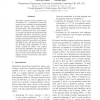Free Online Productivity Tools
i2Speak
i2Symbol
i2OCR
iTex2Img
iWeb2Print
iWeb2Shot
i2Type
iPdf2Split
iPdf2Merge
i2Bopomofo
i2Arabic
i2Style
i2Image
i2PDF
iLatex2Rtf
Sci2ools
EMNLP
2011
2011
Hierarchical Phrase-based Translation Representations
This paper compares several translation representations for a synchronous context-free grammar parse including CFGs/hypergraphs, finite-state automata (FSA), and pushdown automata (PDA). The representation choice is shown to determine the form and complexity of target LM intersection and shortest-path algorithms that follow. Intersection, shortest path, FSA expansion and RTN replacement algorithms are presented for PDAs. Chinese-toEnglish translation experiments using HiFST and HiPDT, FSA and PDA-based decoders, are presented using admissible (or exact) search, possible for HiFST with compact SCFG rulesets and HiPDT with compact LMs. For large rulesets with large LMs, we introduce a two-pass search strategy which we then analyze in terms of search errors and translation performance.
Context Free Grammar | EMNLP 2011 | Natural Language Processing | Representation Choice | State Automata |
| Added | 20 Dec 2011 |
| Updated | 20 Dec 2011 |
| Type | Journal |
| Year | 2011 |
| Where | EMNLP |
| Authors | Gonzalo Iglesias, Cyril Allauzen, William Byrne, Adrià de Gispert, Michael Riley |
Comments (0)

